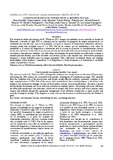| dc.rights.license | http://creativecommons.org/licenses/by-nc-sa/3.0/ve/ | |
| dc.contributor.author | Gordillo, Blanca | |
| dc.contributor.author | Sanabria, Eliana | |
| dc.contributor.author | Mendoza, Nailet | |
| dc.contributor.author | Medina, Mayker | |
| dc.contributor.author | Acosta, Rafael | |
| dc.contributor.author | Ramirez, Alfredo | |
| dc.date.accessioned | 2011-12-16T20:03:39Z | |
| dc.date.available | 2011-12-16T20:03:39Z | |
| dc.date.issued | 2011-12-16T20:03:39Z | |
| dc.identifier.issn | 0798-3166 | es_VE |
| dc.identifier.uri | http://www.saber.ula.ve/handle/123456789/34306 | |
| dc.description.abstract | Este término lo utilizó por primera vez B. Wilson en 1952, aunque esta patología ya era conocida en tiempo de
Hipócrates y durante el siglo XIX se relacionó con los episodios de gangrena de origen estreptocócico. La
mortalidad por esta afección , aun en la actualidad, y a pesar de disponer de tratamientos antibióticos efectivos,
continúa siendo alta, oscilando entre el 7 y 76%. Una de las razones que ha contribuido a estas cifras de
mortalidad es el retraso del diagnóstico y tratamiento ante la escasez en ocasiones de manifestaciones clínicas
locales y/o sistémicas. Se describe el caso de una paciente que desarrolló infección necrotizante de partes blandas,
secundario a traumatismos múltiples. Las infecciones necrotizantes de partes blandas son infecciones cutáneas a
menudo poli-microbianas, que están asociadas con necrosis tisular y que requiere una intervención quirúrgica
temprana y terapia antibiótica para un manejo apropiado. Tales infecciones usualmente tienen una etiología
bacteriológica mixta aeróbica y anaeróbica. Si el diagnóstico es hecho temprano y el tratamiento es instituido
rápido, el pronóstico es bueno. | es_VE |
| dc.language.iso | es | es_VE |
| dc.rights | info:eu-repo/semantics/openAccess | |
| dc.subject | Fascitis necrotizante | es_VE |
| dc.subject | Infección necrotizante | es_VE |
| dc.subject | Fascitis postraumática | es_VE |
| dc.title | Fascitis necrotizante postraumatica. Reporte de caso | es_VE |
| dc.title.alternative | Post-traumatic necrotizing fasciitis. Case report | es_VE |
| dc.type | info:eu-repo/semantics/article | |
| dc.description.abstract1 | This term was used by B. Wilson in 1952, although this condition was already known at the time of Hippocrates,
and during the 19th century was associated with episodes of gangrene of estreptocócico origin. The mortality
from this condition even at the present time, and despite having effective antibiotic treatments, continues to be
high, ranging between 7-76%. One of the reasons that contributed to these mortality figures is the delay in the
diagnosis and treatment to shortages at times of local and/or systemic clinical manifestations. Describes a patient
that developed Necrotizing soft tissue infection secondary to multiple injuries. Necrotizing soft tissue infections
are often poli-microbianas skin infections, which are associated with tissue necrosis and which requires early
surgery and antibiotic therapy for appropriate management. Such infections usually have a mixed aerobic and
anaerobic biological etiology. If the diagnosis is made early and the treatment is instituted quickly, the Outlook is good. | es_VE |
| dc.description.colacion | 63-66 | es_VE |
| dc.description.email | elisp81@hotmail.com | es_VE |
| dc.description.email | menroma@hotmail.com | es_VE |
| dc.description.email | boastsiwain@hotmail.com | es_VE |
| dc.description.email | alfrim@hotmail.com | es_VE |
| dc.description.email | blancidmed@hotmail.com | es_VE |
| dc.identifier.depositolegal | 19910ME310 | es_VE |
| dc.subject.facultad | Facultad de Medicina | es_VE |
| dc.subject.keywords | Post-traumatic fasciitis | es_VE |
| dc.subject.keywords | Necrotizing fasciitis | es_VE |
| dc.subject.keywords | Necrotizing infection | es_VE |
| dc.subject.thematiccategory | Medicina y Salud | es_VE |
| dc.subject.tipo | Revistas | es_VE |
| dc.type.media | Texto | es_VE |


